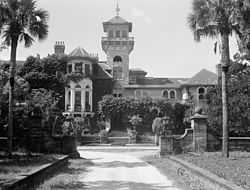Dungeness (Cumberland Island, Georgia)
|
Dungeness Historic District | |
 | |
|
Dungeness in 1958 | |
| Nearest city | St. Marys, Georgia |
|---|---|
| Architect | Multiple |
| Architectural style | Queen Anne, Shingle Style |
| Governing body | National Park Service |
| MPS | Cumberland Island National Seashore MRA |
| NRHP Reference # | 84000920 |
| Added to NRHP | February 13, 1984[1] |
Dungeness on Cumberland Island, Georgia, is a ruined mansion that is part of a historic district that was the home of several families significant in American history. James Oglethorpe first built on Cumberland Island in 1736, building a hunting lodge that he named Dungeness. The next Dungeness was the legacy of Revolutionary War hero Nathanael Greene, who had acquired 11,000 acres (45 km2) of island land in exchange for a bad debt. His widow built a four-story tabby mansion in 1803, over a Timucuan shell mound. During the War of 1812 the island was occupied by the British, who used the house as a headquarters.
In 1818 Henry Lee III, known as Lighthorse Harry Lee and father of Robert E. Lee, stayed at the house until his death and was buried there for a time. This house was abandoned during the U.S. Civil War and burned in 1866.[2]
In the 1880s the property was purchased by Thomas M. Carnegie, brother of Andrew Carnegie, who began to build a new mansion on the site. The 59-room Queen Anne style mansion and grounds were completed after Carnegie's death in 1886. His wife Lucy continued to live at Dungeness and built other estates for her children, including Greyfield for Margaret Carnegie, Plum Orchard for George Lauder Carnegie, and Stafford Plantation. By this time, the Carnegies owned 90% of the island.
The Carnegies moved out of Dungeness in 1925. In 1959 the Dungeness mansion was destroyed by fire, alleged to be arson.[2] The ruins are today preserved by the National Park Service as part of Cumberland Island National Seashore. They were acquired by the Park Service in 1972.[3]

The main house comprises a portion of the larger historic district, which includes servant's quarters, utility buildings, laundries, cisterns, and a variety of other structures.[4] The district forms a planned, landscaped ensemble. The most significant supporting structure is the Tabby House or Nathanael Greene Cottage, which dates to the Greene family's tenure.[3]
References
- ↑ "National Register Information System". National Register of Historic Places. National Park Service. 2008-04-15.
- ↑ 2.0 2.1 "Dungeness (Cumberland Island, Ga.)". Digital Library of Georgia. 2009-01-14.
- ↑ 3.0 3.1 "Dungeness Mansion Ruin". List of Classified Structures. National Park Service. 2009-01-14.
- ↑ "Dungeness Negro Servants' Quarters". List of Classified Structures. National Park Service. 2009-01-14.
External links
| Wikimedia Commons has media related to Dungeness (Cumberland Island, Georgia). |
- Historic American Buildings Survey (HABS) No. GA-2160, "Dungeness, Cumberland Island, Cumberland Island, Camden County, GA", 6 photos, 2 measured drawings, 4 data pages
- HABS No. GA-2161, "General Nathaneal Greene Cottage, Cumberland Island, Cumberland Island, Camden County, GA", 4 photos, 3 measured drawings, 2 data pages
| ||||||||||||||
| ||||||||||||||||||||||||||
Coordinates: 30°44′54″N 81°28′15″W / 30.748441°N 81.47087°W